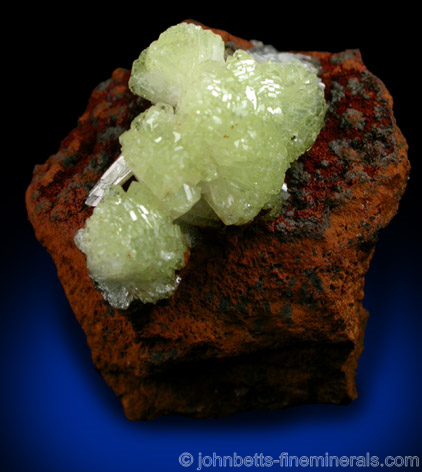The Mineral adamite

Adamite occurs in many different lively colors. Different impurities are responsible for the color types.
When copper is present in Adamite, this gives a vibrant green or blue color, and when cobalt is present, it gives a pink to purple color. Some impurities such as copper prevent the Adamite from its habit of being fluorescent.
Adamite crystals are usually embedded in rusting, crumbly, brown
Limonite matrix that stain the hands. Since the Limonite
crumbles when scrubbed, care must be exercised when washing such
specimens.
Chemical Formula
Zn2(AsO4)(OH)
Color
Light to dark yellow, greenish yellow, green, greenish blue, sky blue, pink, purple, orange; rarely colorless, white, or red. Sometimes multicolored.
Crystal System
Orthorhombic
Crystal Habits
As clusters of short, stubby crystals, but sometimes occurs in elongated prisms, usually in groupings. Also occurs acicular, radiating, and globular.
Varieties
-
Adamite containing cobalt in its structure, which replaces some of the zinc. The presence of cobalt gives this variety a purple color. Its chemical formula is (Zn,Co)2(AsO4)(OH).
-
Adamite containing copper in its structure, which replaces some of the zinc. The presence of copper gives it a vibrant blue to green color. Its chemical formula is (Zn,Cu)2(AsO4)(OH). Zincolivenite, a new mineral name approved by the IMA in 2006, is now a recognized mineral specimen which contains an intermediary amount of copper and zinc, and is part of the Adamite-Olivenite series.
Uses
Adamite is a fine specimen mineral, and is in demand by mineral collectors for its pretty crystals. Adamite is a minor ore of zinc.
Noteworthy Localities
The most magnificent occurrence for this mineral is without doubt the
Ojuela Mine in Mapimi, Durango, Mexico, where large, beautiful, and
highly fluorescent examples occur in all different colors. Other important occurrences are Lavrion, Greece; Cap Garonne, France; Tsumeb, Namibia; the Brenner Mine, Dal'negorsk, Russia; and Nandan, Guangxi, China. In the U.S., the best occurence is Gold Hill, Tooele Co., Utah. Small colorless crystals were also found at Chloride Cliff in Death Valley, Inyo Co., California.
Distingushing Similar Minerals
Olivenite - Usually has a greener color and usually occurs in tall, thin crystals.
Smithsonite - Usually occurs globular, and doesn't fluoresce.
Paradamite - Different crystal form.